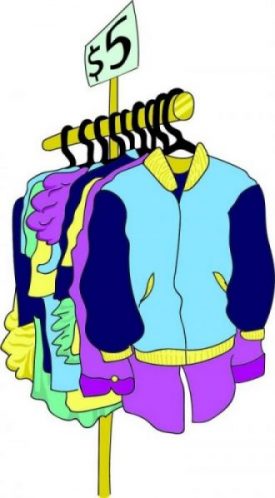Discounted clothing hangs on a rack. While fast fashion represents a cheaper option, thrifting and slow fashion are more sustainable when it comes to choosing where to shop. Illustration by Lilli Sams and photo illustration by Shea Peters
Clothing choices go beyond skin deep when the unethical and unsustainable practices of the fast fashion textile industry are taken into account.
Clothing accounts for up to 10% of an individual’s environmental impact, according to a report by the European Parliamentary Research Service. The vast amount of resources required to produce clothing means that, despite being a fun hobby, shopping cannot be taken lightly.
According to the World Wildlife Fund, one kilogram of cotton requires 20,000 liters of water to grow. Given that over 19 billion garments per year are produced, used and disposed of, according to the Environmental Protection Agency, this is environmentally unsustainable.
Moreover, while nearly 100% of clothing is recyclable, roughly 85% of apparel ends up in landfills, according to the World Wear Project.
One cause of this massive waste of clothing is fast fashion, the mass production of cheap, low-quality clothing. The lifespan of fast apparel is quite short, leading to higher turnover and more waste. According to the World Resources Institute, despite individuals purchasing 60% more clothing compared to 14 years ago, each garment is thrown out twice as quickly.
Thrifting has emerged as a popular way to combat the environmental harm caused by fast fashion, while simultaneously curating a unique and affordable look.
While thrifting is successful in reducing the rates of clothing accumulation in landfills and promoting reuse of clothes, it does not address the rampant production of new clothing present in the fast fashion system. Additionally, increased demand for thrifted goods may drive prices up, making them less accessible for people who rely on their affordability.
For those who have the choice, slow fashion choices may be the answer. According to an article published by The Ecologist, slow fashion emphasizes the production of ethically-sourced, sustainable products with a longer lifespan.
While both thrifting and slow fashion have merits and detriments, they are far superior to the overconsumption encouraged by fast fashion apparel. Though the environmental and ethical issues surrounding the textiles industry are complex, individuals can make a real impact through their purchasing power.
